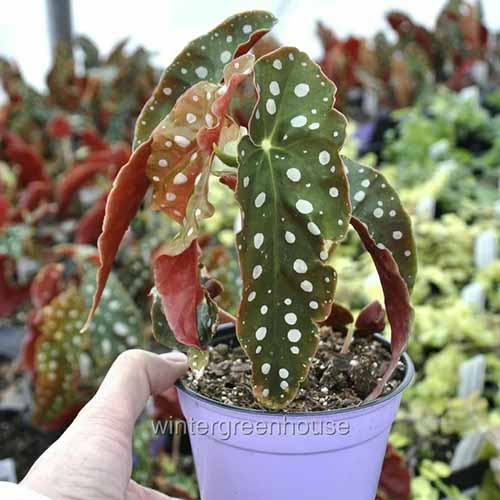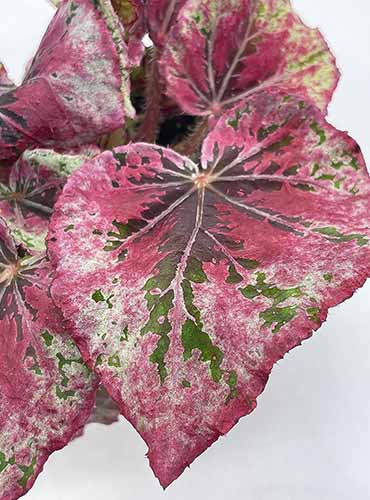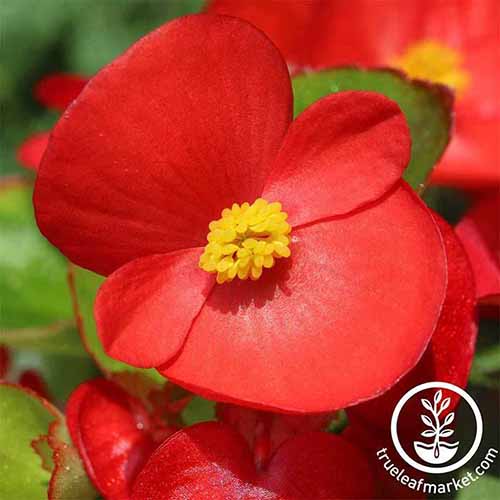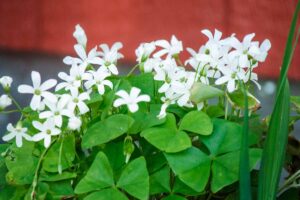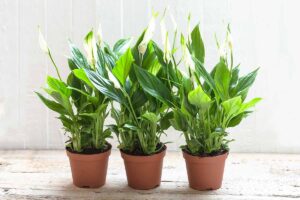The further you delve into the world of begonias, the more you realize just how versatile this genus can be.
Different types are standouts for mass plantings, cottage gardens, window boxes, and shady patios, or a go-to for Mother’s Day hanging baskets.
But if that’s as far as you’ve gone with Begonia Appreciation – the outdoor growing options – I’d like to invite you indoors.
Certain species will grow as perennials only in Zones 9 to 11 or 10 to 12, but they excel as year-round houseplants.
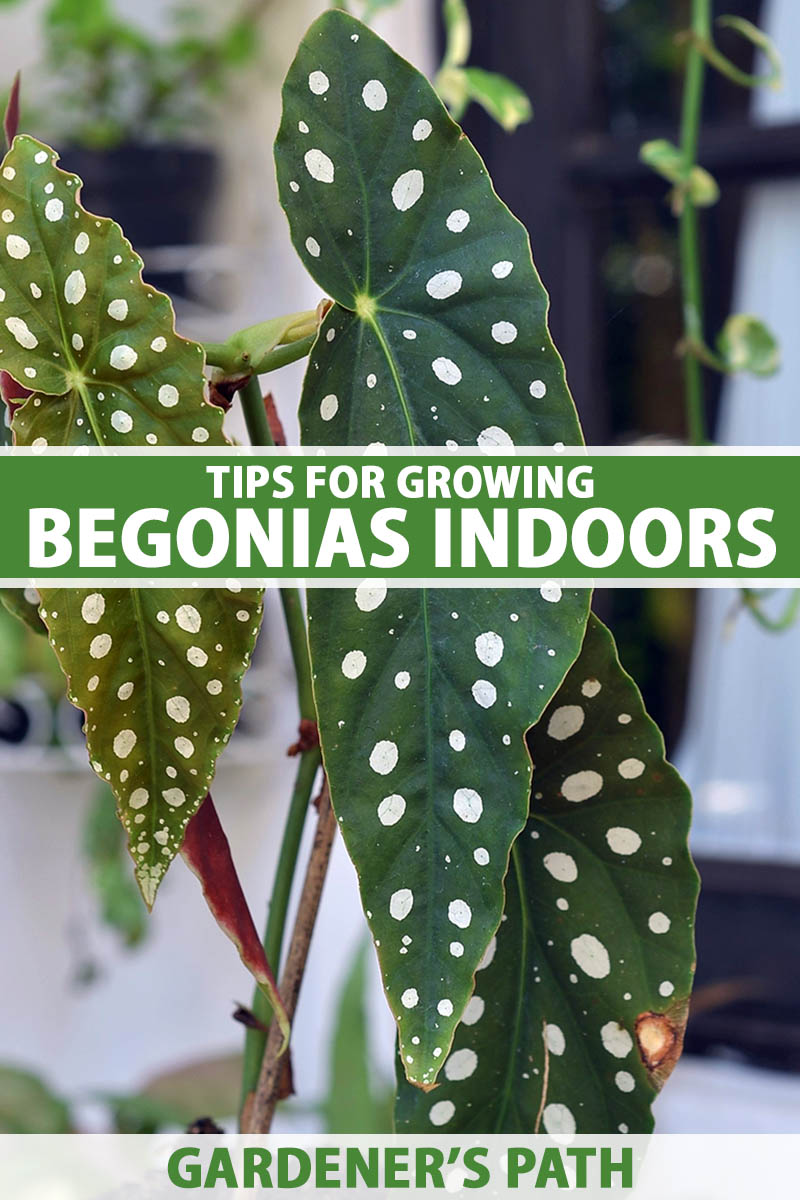
We link to vendors to help you find relevant products. If you buy from one of our links, we may earn a commission.
The worthy candidates for indoor growing include varieties that bloom indoors even in winter and plants from a couple of groups that produce dramatic, colorful foliage year-round.
As you might imagine, grown as houseplants, these varieties will need more care and attention than the typical outdoor hanging basket tossed at season’s end or the winter-hardy begonias that spread via bulbils each fall.
These indoor types don’t fend for themselves, but their lavish foliage, stately stems, and perhaps even clusters of blooms will pay back any extra effort.
Most importantly, these varieties can open up possibilities for folks who don’t have a garden bed or other outdoor space to grow ornamentals.
If you’re new to the idea of growing begonias inside, welcome! You have lots of fun options to look forward to.
Or are you here to troubleshoot issues with begonias growing in your home, or because you have a specific question about houseplant begonia care? If so, this guide will provide tips and answers for those with more experience, too.
Here’s what I’ll cover:
What You’ll Learn
Cultivation and History
The Begonia genus includes more than 2,000 species native to parts of South America and other tropical areas worldwide.
In 1700, Franciscan monk and botanist Charles Plumier first described this genus and honored the then-governor of Santo Domingo, Michel Begon, with the name.
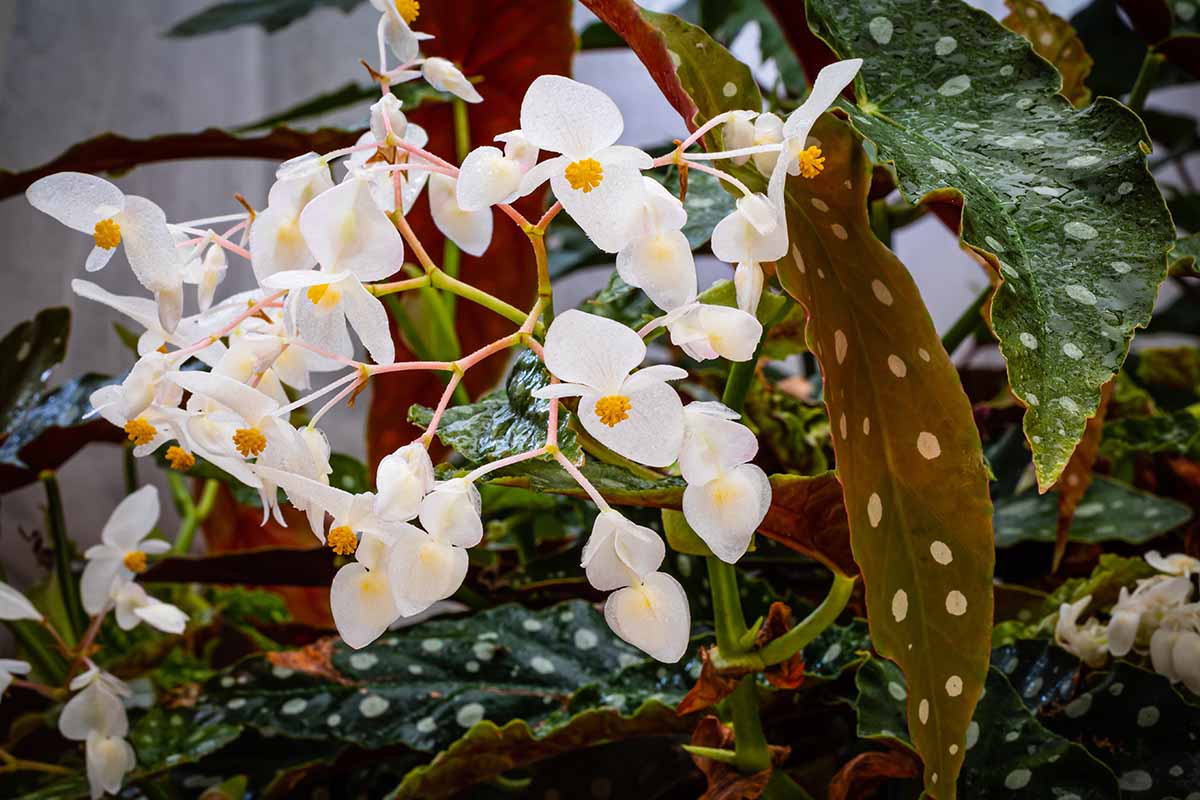
In the intervening centuries, the plants were brought from continent to continent, becoming especially popular in Europe. Begonias are now grown worldwide.
Because the species hybridize so readily, the available varieties are wildly diverse, though most have thick, fleshy stems.
Some are prized for their patterned, swirling leaves in beautiful shades, others their sprays of pink, red, or white blooms, and some hybrids deliver beauty in foliage and flowers.

Some grow on single stems, others creep along the ground on rhizomes, and others stem from tubers below the soil.
The choices are vast, but many varieties offer extra advantages as houseplants. Let’s take a look.
Types of Begonias That Thrive as Houseplants
While any type can be grown inside at least for a time in a container, some varieties are better houseplant candidates than others.

First, I’ll mention two that I wouldn’t select to grow year-round indoors.
The first is the hardy type, B. grandis, which grows via underground tubers. This type is unusual because it is hardy in Zones 6 to 9, areas that experience hard freezes in the winter.
While you can plant hardy types in containers to enjoy inside from spring to fall or dig the plants up to overwinter indoors, they will die back over the winter whether inside or out.
They sort of fall apart into heaps, which is a pretty unappealing trait in a houseplant. And they require temperatures in the 40 to 50°F range for overwintering so the average household climate won’t work.
I recommend reserving these blooming beauties for outdoor plots and containers and moving them into a shed or garage to survive the winter.
The best-known tuberous begonias, B. x tuberhybrida, are okay to enjoy as indoor plants during their growing and blooming season in the spring and summer. They’re hardy in Zones 9 to 11.
But they’re not optimal houseplants because they die in the winter when they’re dormant, which is not a glad sight in the houseplant display.
To keep them alive over winter, you must lift and store the tubers in a chilly spot and replant them in the weeks leading up to spring.
If you’d like to grow them season after season this way, follow the directions in our guide to winterizing begonias.
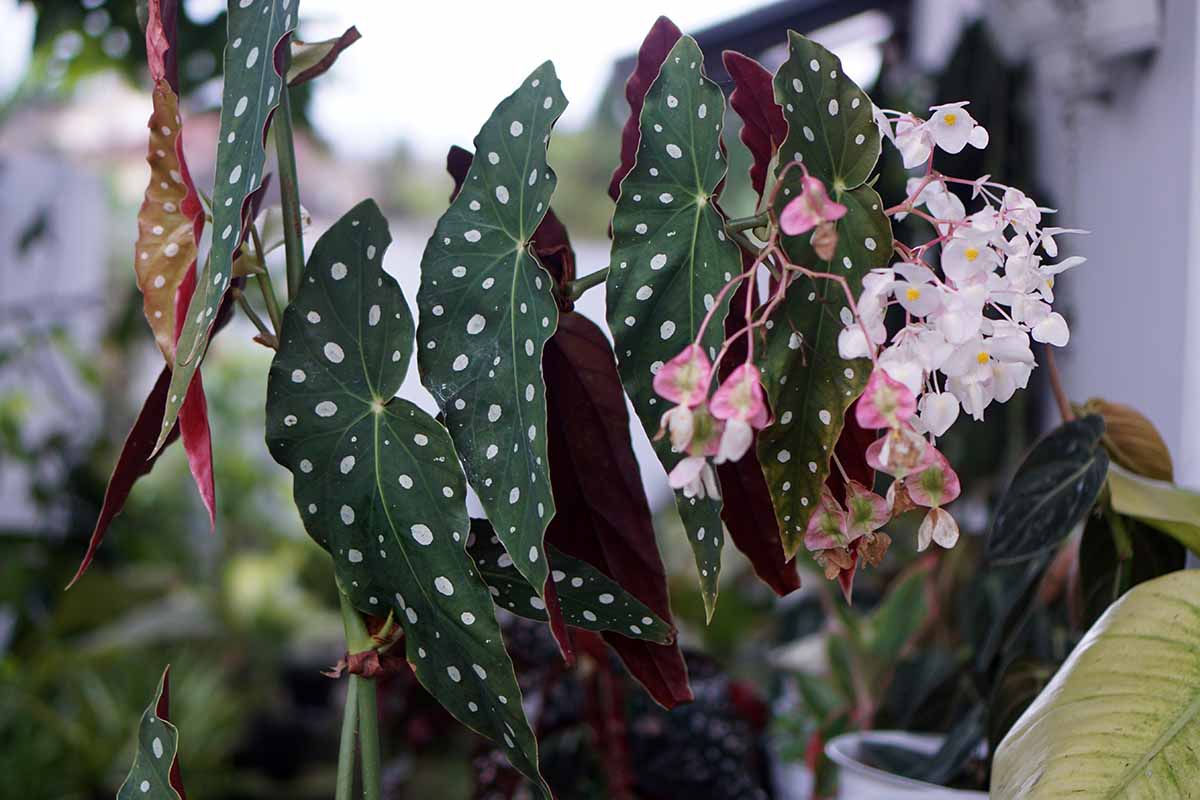
With those two less-than-ideal varieties out of the way, let’s get to the good part: the types that do not go dormant and can thrive indoors all year.
I’ll give my favorites, rex begonias (B. x rex-cultorum), special consideration and start with them. These varieties are grown for their arty, sometimes dramatic, and always colorful foliage.
Outdoors, they’re hardy in Zones 10 to 12, but they’ll thrive from January to December indoors in pots.
Most rex cultivars grow from rhizomes that spread along and below the soil, but others have fibrous roots.
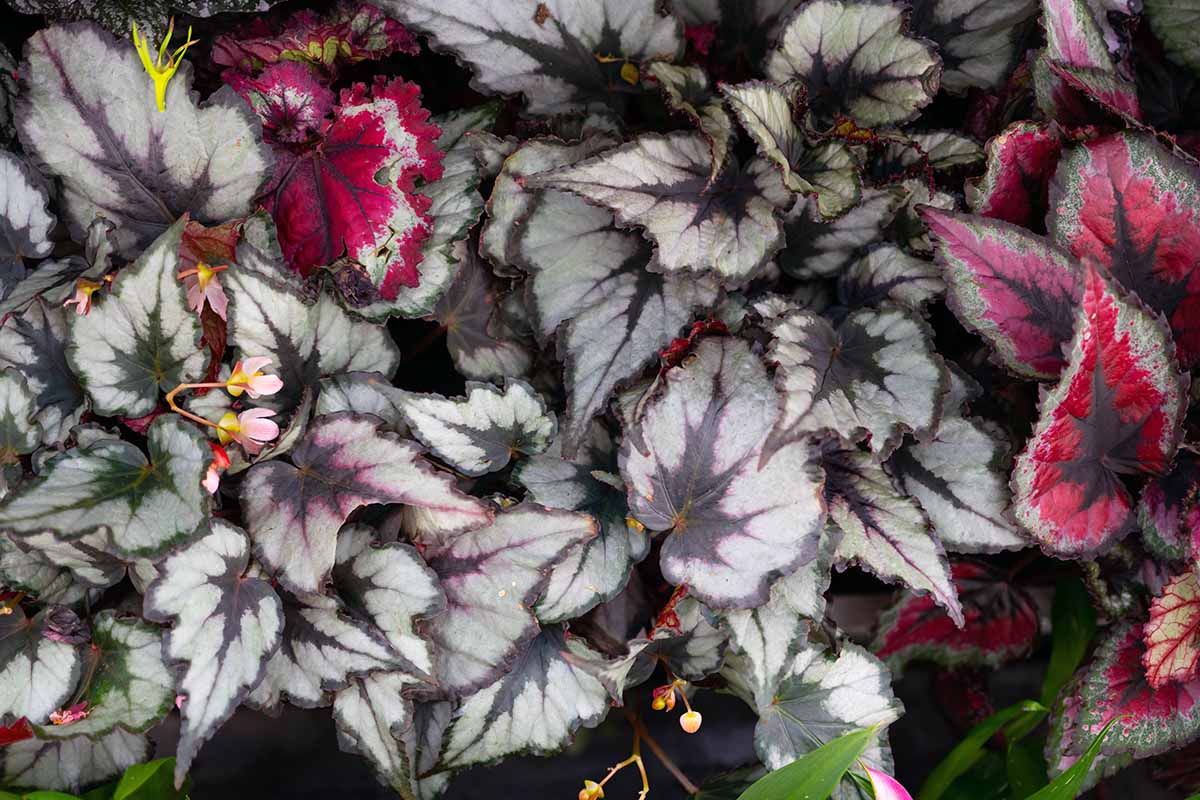
Other rhizomatous types are also appealing for indoor cultivation, and though they’re less colorful than B. x rex-cultorum, they are a bit easier to maintain.
One example is the spritely B. goegoensis, with its bronze-green leaves and pink flowers.
Next in the viable houseplant category are the cane types, which may bloom indoors and reach heights of up to six feet in the right growing conditions.
This group includes angel-wing begonias with wing-shaped leaves and showy clusters of dangling blooms in pink, white, or perhaps red.
The other species ideal for growing as a houseplant might surprise you.
Those same wax (B. x semperflorens-cultorum) varieties that brought such cheer to your grandma’s garden bed and window boxes can also thrive indoors and even bloom throughout the year.

The variety in their foliage, blooms, and size, and the ease of propagating new starts, make this one of the most accessible and affordable plants that will bloom inside the house.
For the scoop on growing wax and cane as well as rex and other rhizomatous begonias indoors, keep reading.
Recommended Indoor Growing Conditions
Ah, there’s always a catch, isn’t there? When you grow a plant native to the tropics, it takes extra effort to provide for its growing requirements indoors.
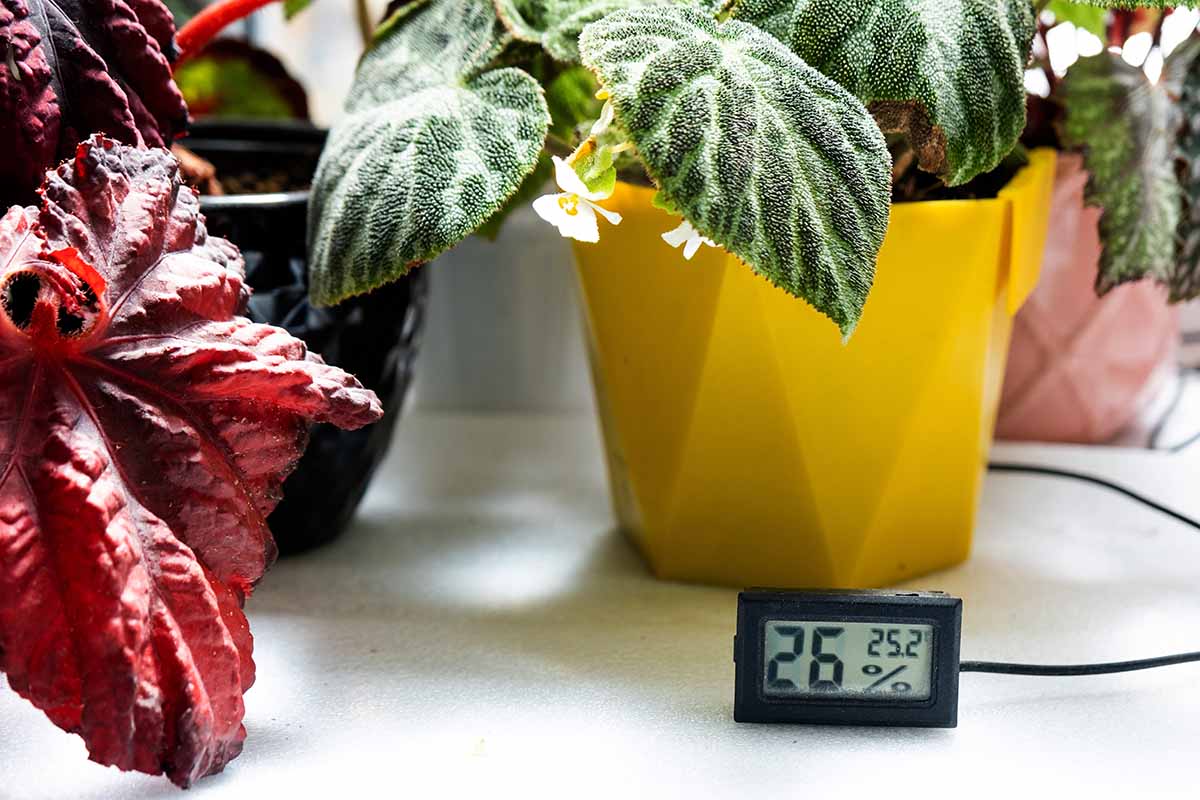
If you’re a dedicated indoor gardener like me, it won’t take long to fall into a routine that makes it easier to provide for those needs.
It’s not as simple as letting the sun, rain, and mist do the work for you, but once you get used to the drill, it’s not too tough.
These are the top considerations:
Temperature
Begonias do well in the average home temperature, between 65 and 80°F.
They can hack temperatures as low as 55°F but get stressed when it’s colder than that. At temperatures below 50°F, they may also freeze.
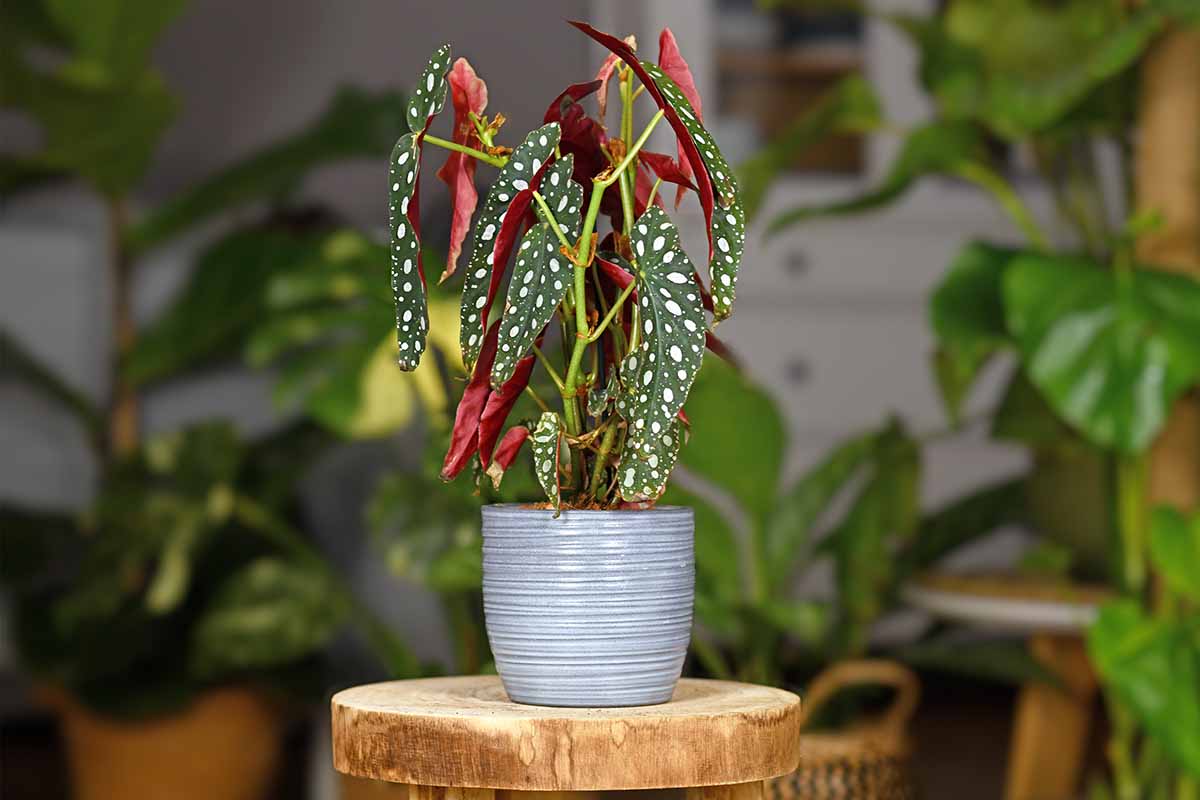
Always check the label if you’re ordering unfamiliar varieties online or purchasing them locally.
Occasionally, a begonia hybrid has been bred to tolerate temperatures outside the usual range.
And as I mentioned earlier, tuberous begonias need chilly, not warm, temperatures to overwinter, and hardy types can survive sub-zero temperatures but die in the winter, even indoors.
You’ll want to place houseplant begonias somewhere out of drafts and away from family pets since the leaves are toxic.
If you like, you can move the plants outdoors in their containers once the temperatures exceed 60°F during the day and bring them back in when daytime temperatures fall below 60°F.
The advantage to this is that they will grow bigger, bloom more, and experience superior air circulation outdoors. But there’s also a potential drawback: the plants tend to bring pests and pathogens with them when you bring them back inside.
Light
While outdoor specimens might grow fine in partial shade, those same plants require bright, indirect light when grown indoors.
A window with direct sun is fine if you filter it with a sheer curtain, but a location one to three feet from a sunny window is superior.
Or, you can opt to use grow lights – learn more in our guide.
Containers
Begonia pots must provide drainage. Choose a container with drainage holes at the bottom and place a saucer below to catch any excess water so you can dispose of it.
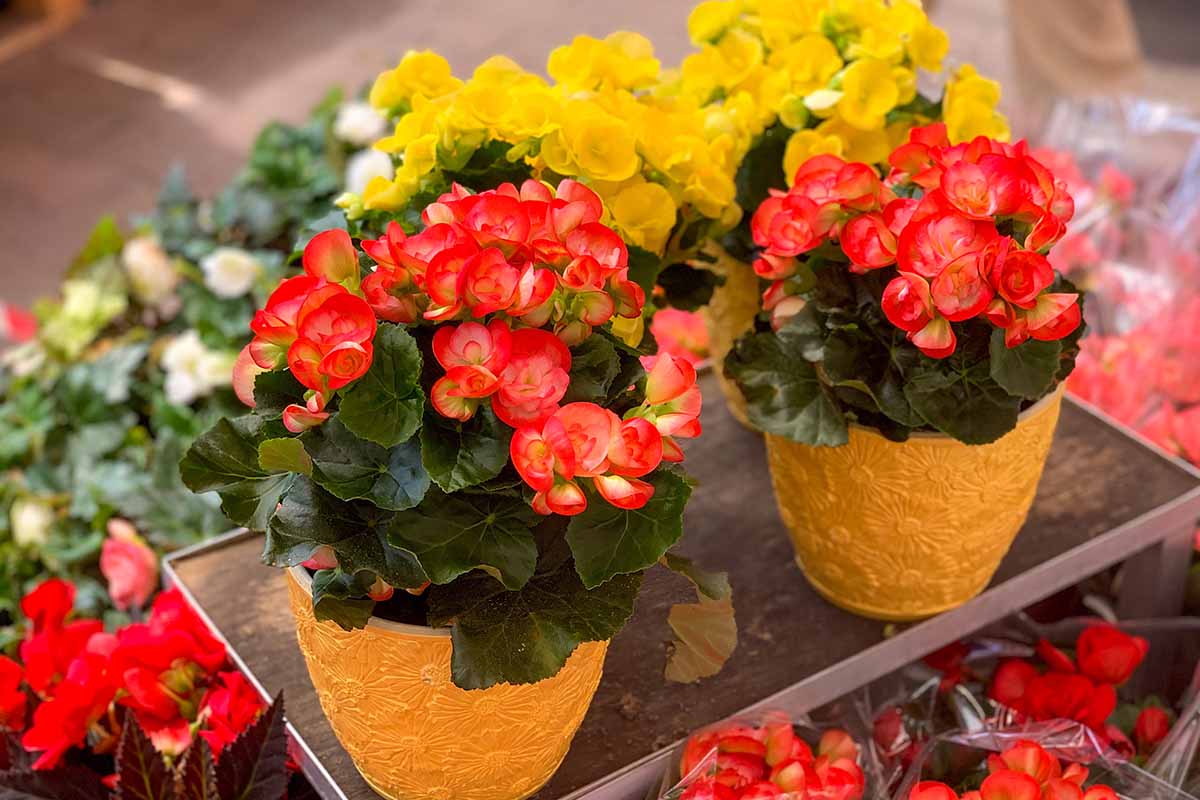
The material isn’t so important, but you should favor more lightweight pots for cane begonias since they get so big and you may want to move them outdoors in summer. A ceramic pot any bigger than six inches wide could prove too heavy.
Also, the pots should be only three or four inches deep and just an inch or two wider than the plant you intend to grow there. These plants have shallow roots and prefer snug quarters.
A hanging basket is fine as long as the bottom of the container offers proper drainage. Test it ahead of time.
If excess water only drains away when you tilt the pot at an angle, you’ll need to find something else.
Learn more about selecting pots and planters in our guide.
Soil and Drainage
Well-draining soil that’s moderately rich in composted organic matter is essential for indoor begonias. A mix of a peat alternative, sand, and compost will work. Or, an ordinary potting mix formulated for indoor plants is ideal.
If you are sourcing your plants from a garden bed, remove some of the soil from their roots and replace it with a sterile mix inside the pot.
When you’re filling containers for transplants, don’t try to use a prepackaged garden bed mix you have on hand, much less dirt from the yard.
Either tends to be too compact, and the soil from your property may contain harmful pathogens.
You can learn more about selecting the best houseplant soil in our guide.
Humidity
Air moisture can be a sticking point for those who want to grow begonias as houseplants. In general, they prefer at least 40 percent humidity. A bathroom or kitchen location is suitable if it also offers ample light.
You can also provide a pebble tray beneath the pot, making certain the water level reaches about halfway up the pebbles without touching the bottom of the pot.
I’m sorry to say misting to add humidity won’t work.
You’d have to mist at least three times a day to bump up the humidity significantly, and that frequency can increase the odds of leaving droplets behind, which may cause leaf spots.
If need be, you can invest in a humidifier, but I recommend seeing how the plants do first and adjusting as needed.
Care and Maintenance Tips
As long as they’re growing in a spot and in soil that suits them, ongoing care for houseplant begonias is straightforward.
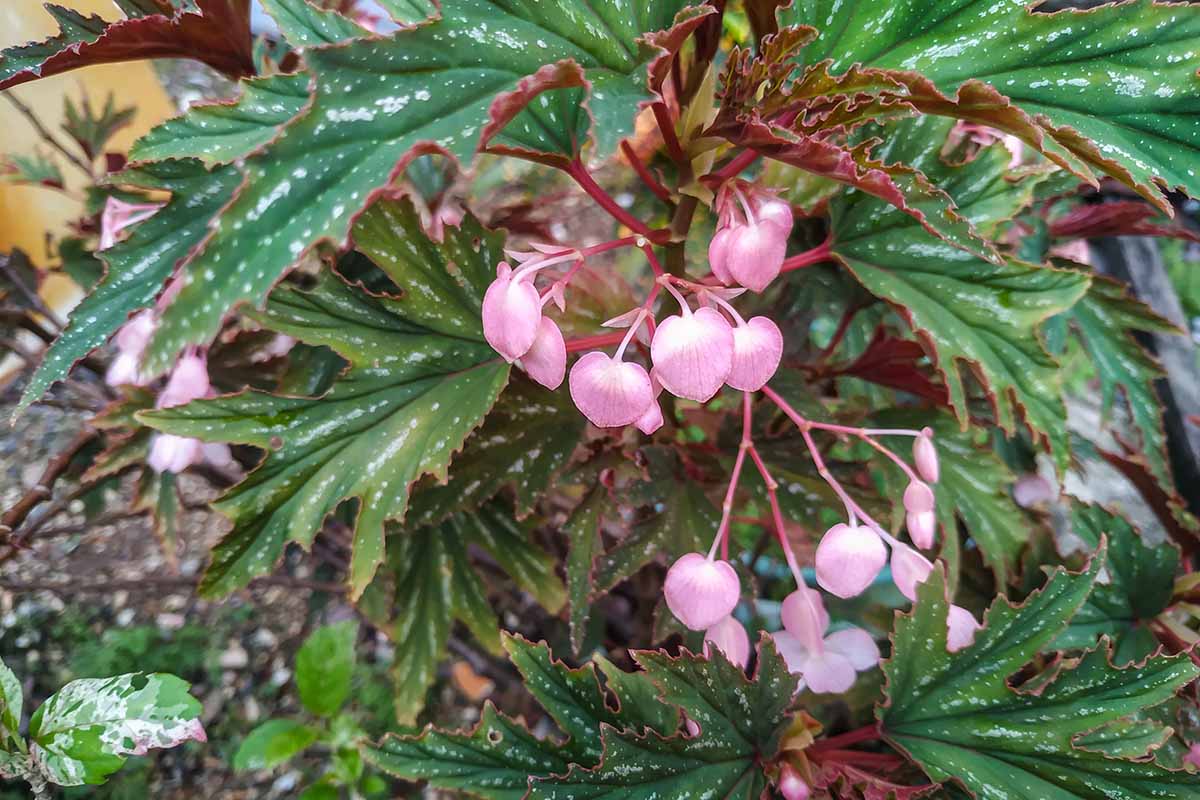
You’ll want to keep them watered well, about an inch per week applied at the soil line, not splashed from above onto the leaves.
Instead of doing this on a regular schedule, which can lead to overwatering, water when the soil is dry at least an inch down. Plunge your pinky into the edge of the pot to determine dryness, or use a moisture meter.
It’s also an indicator that the soil is too dry if the leaves are brown at the margins or tips.
After each hydration session, give the plants at least 15 minutes to drain properly and discard the excess. They’re prone to stem and root rot if they get wet feet.
Indoor begonias will benefit from fertilizing with an all-purpose liquid plant food diluted to half strength and applied every 14 days.
As for ongoing maintenance, most types don’t need pruning to be happy, but you may want to trim back cane varieties if they’ve gotten gangly.
Spring is the best time, and you can trim the stems to the bottom four nodes, along with cutting any brittle or dead stems.
Alternatively, you can stake upright varieties with lightweight supports.
Make sure to deadhead spent flowers regularly and clip any leaves or stems that have turned brown. Also, pick up dead leaves and flowers that fall on the soil surface as soon as you see them to discourage fungal diseases.
Another nice thing about growing begonias in containers is that you don’t have to repot often.
You’ll know it’s time if a rhizomatous variety has rhizomes literally pressing on the edges of the pot or growing over the edges.
Wax and cane types should be repotted when they’re too snug in their pots, usually only once every two or three years.
Repot in spring if possible, and choose a new container at most two inches wider than the old pot.
And speaking of spring, if you do want to give indoor begonias a vacation outdoors in the warm months, make sure to start only after the temperatures are reliably above 60°F outdoors.
It’s also important to spend at least a week gradually acclimating the plants to the new levels of light and humidity.
This is one time when these plants are demanding: they don’t like abrupt environmental changes and will respond by dropping leaves or flowers, or starting to die back altogether.
When you bring the plants back inside for the winter months, do that gradually, too. And be especially careful to note and eliminate any insects or arachnids that try to hitchhike back indoors with your begonias.
Begonia Cultivars to Select
Ready to commit to a plant or seeds to start inside? Here are three worthy options for you to consider:
Cane: Polka Dot
Growing straight and tall on canes that reach 18 to 28 inches in height, polka dot begonias, B. maculata, have deep green leaves with translucent maroon undersides.
They get their name from the white polka dots on the faces of their wing-shaped leaves.
Polka dot begonias typically flower in the period from spring to late summer, but don’t be surprised if their white bell-shaped flowers show up at other times of the year too.
Polka dot begonia is available in four-inch pots from Winter Greenhouse via Walmart.
Rex: Harmony’s Venetian Red
If you strictly grow this colorful rex begonia indoors, make sure to give it plenty of indirect light so its initial pink and magenta hues will develop into a rich red color.
The leaves are shaped like hearts, and the margins have irregular edges that soften their shape.
Harmony’s ‘Venetian Red’ is available in a four-inch pot from Walmart.
Wax: Vodka Deep Red
Part of the Cocktail series, ‘Vodka’ wax begonias grow eight to 12 inches tall. Each plant will spread about 10 inches, wide enough to fill a planter eight inches wide.
It will take at least 115 days for seeds started indoors to bloom. But your reward will be these cheery red wax begonias with shiny, red-edged leaves and bright yellow centers.
Pelleted seed is necessary since the seeds are practically microscopic.
You can find packets of 50 pelleted ‘Vodka’ seeds available from True Leaf Market.
Managing Pests and Disease
If you’re careful to get rid of pests before moving plants inside, they should be relatively problem free.
Those that do show up can be countered quickly with a strong spray of water or by applying neem oil, a natural fungicide and pesticide.
A few pests to watch out for include mealybugs, scale, spider mites, and thrips. Check out our guides to each of these pests for tips on detection and control.
In general, if you steer clear of poor air circulation, inadequate drainage, and overwatering, you can avoid most diseases that could afflict begonia houseplants, including fungal diseases like powdery mildew and leaf spot.
The fungus Botrytis cinerea causes botrytis, which will announce its presence on flowers first. You can prevent it by deadheading the blooms and clipping and destroying damaged or browning leaves immediately.
Stem rot is another destructive foe. It’s caused by the water mold Pythium ultimum, so don’t overwater if you want to spare your houseplants from this often deadly ailment.
Also, ensure you don’t plant rhizomatous begonias with their rhizomes all the way beneath the soil.
You may need to rotate between different fungicides to counter the risk of stem rot.
Quick Reference Growing Guide
| Plant Type: | Flowering herbaceous perennials | Flower/Foliage Color: | Orange, pink, red, white, yellow/green, bronze, multicolor combos including blood red, chocolate, cream, deep purple, hot pink, khaki, lavender, lime green, maroon, pink |
| Native to: | South America and other tropical regions, cultivated hybrids | Water Needs: | Moderate |
| Hardiness (USDA Zones): | 9-12, depending on variety | Maintenance: | Low to moderate, depending on species |
| Bloom Time/Season: | Year-round or spring-early autumn, depending on the species | Tolerance: | Underwatering for short periods |
| Exposure: | Bright, indirect light | Soil Type: | Moist, humus rich (tuberous and cane); porous, peat-based, amended with compost (other types); average potting mix (all varieties) |
| Spacing: | 1 per 6-inch pot (wax), pot 2-3 inches wider than root ball (cane, rhizomatous, other hybrids with fibrous roots) | Soil pH: | 5.5-7.0 |
| Planting Depth: | Pressed into soil surface (pelleted seeds), top half of rhizome visible above soil (rex and rhizomatous), slightly below soil line (tubers), crown even with soil surface (other fibrous-rooted varieties) | Soil Drainage: | Well-draining |
| Height: | 8 inches-6 feet (cane); 6-18 inches (rex, rhizomatous, tuberous, wax) | Family: | Begoniaceae |
| Spread: | 6-24 inches | Genus: | Begonia |
| Common Pests and Diseases: | Mealybugs, spider mites, thrips; begonia leaf spot, botrytis blight, powdery mildew, root rot, stem rot | Species: | Coccinea, maculata, rex x cultorum, x semperflorens-cultorum, x tuberhybrida |
Invite Begonias into Your Home
Any colorful houseplant is welcome in my home, but I particularly enjoy growing begonias indoors because they’re so simple to start from cuttings.
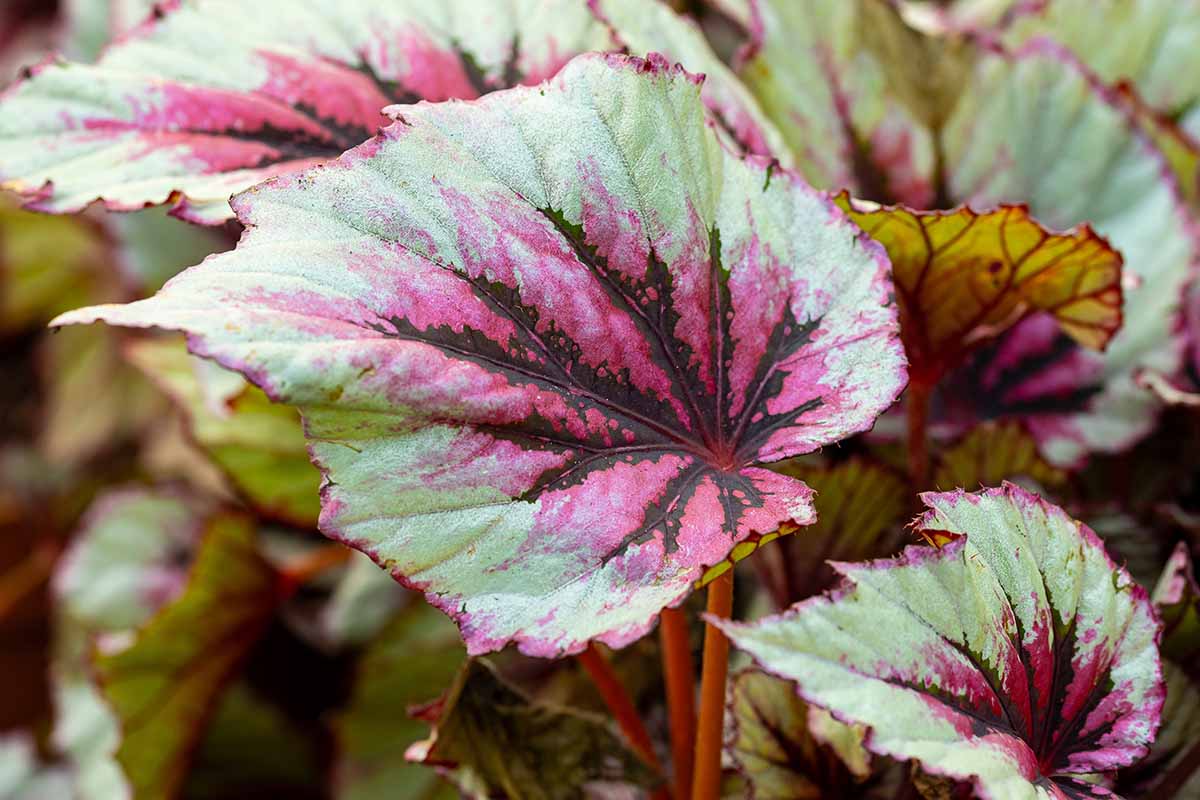
That makes it easy to expand my collection and share starts with friends and family so they can have beautiful indoor specimens, too.
Do you have any experience or questions to add to the comments section below? We’d appreciate your input and will field questions as soon as possible.
For helpful growing tips, read these begonia guides next:
